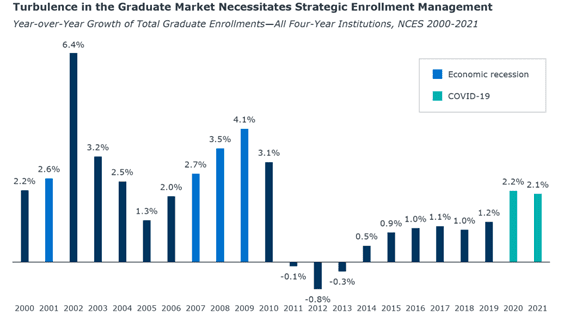6 elements of an effective graduate enrollment management plan—and why you need to build one
October 14, 2022
On a few recent campus visits, graduate school deans shared that they are tasked with growing enrollment by as much as 30 or 35 percent. But not all the schools I speak with have a clear strategy for how to achieve these lofty grad growth goals. In other words, they haven’t yet created an enrollment management plan for grad programs akin to the strategic enrollment management (SEM) plans most institutions develop for their undergrad programs.
Today’s market conditions, combined with expected enrollment shifts in the years to come, mean that it’s more important than ever to have an effective graduate enrollment management (GEM) plan in place. Here’s why your institution needs a robust GEM plan-and how to build one.
Why do institutions need a GEM plan?
While the past 20 years have been a time of rapid expansion for graduate enrollment, that growth has not been consistent or easily achieved. As illustrated in the bar chart below, the last two decades have been characterized by a few distinct challenges:
- growth in online education,
- a rapidly evolving competitive landscape,
- economic recessions, and of course,
- a global pandemic.

The countercyclical nature of graduate enrollment, coupled with demographic changes during this period, means that grad programs overall often grew during these tumultuous times. But what’s missing from this snapshot is the fact that the pace of graduate enrollments and conferrals is slowing. Graduate enrollments have grown only an average of 0.7 percent since 2010, while conferrals increased 2 percent on average in the same period. And undergraduate enrollment-our pool of future graduate students-declined 12.4 percent from 2010 to 2020. External forces such as these are just one reason why a GEM plan is critical to the success of graduate programs. A GEM plan can create consistency and predictability amid this volatility.
-
47%
of surveyed graduate enrollment leaders say there is an increased reliance on graduate enrollment at their institution to offset undergraduate enrollment shortfalls.
What elements should inform your GEM plan?
A GEM plan is not just about solidifying enrollments and revenue—it’s about making the right choices for how your institution can best compete in the marketplace. To make these decisions, institutions need to consider six core elements:
1. Internal and External Environmental Scan
The internal and external environmental scan is a major aspect of effective GEM planning. These scans typically address questions related to recruitment, retention, and revenue. The institutional research department is often responsible for collecting the relevant data and providing that data back to decision-makers who then create strategic enrollment goals based on this information.
2. Program Development
An essential element of GEM models that is often left out of or glossed over in the literature is the academic program development process. Program development, whether for new or existing programs, is a key academic affairs function, but is often not tied to the institution’s overall growth strategies or mission. To be more student-centric during program development, consider the following questions:
- What is the program’s market viability?
- What is the program’s modality?
- What are the program’s competitive advantages?
DOES YOUR PROGRAM DESIGN SUPPORT ENROLLMENT GROWTH
3. Marketing and Recruitment
Graduate enrollment plans will not be successful without structured marketing efforts aligned to the objectives of the GEM plan. And as graduate enrollment leaders know, the marketing tactics and messages that support undergraduate programs won’t all resonate with prospective graduate students. Adult students are especially likely to evaluate academic programs from a consumer’s perspective and seek programs which demonstrate a return on investment (e.g., career advancement, career change).
YOUR FUTURE GRADUATE STUDENTS WILL BE INCREASINGLY HARD TO FIND. HERE’S WHY
4. Tuition and Financial Aid
Tuition and financial aid, or discounting, have long been important strategies for yielding undergraduate classes. The same can now be said for yielding graduate classes. First, tuition rates should be evaluated on an annual basis through a thorough review of competitive programs as part of the external environmental scan. Second, both tuition and financial aid are important to the calculation of net tuition revenue (NTR) and achieving the financial goals of the plan. NTR can be calculated as Total Annual Tuition minus Discount/Scholarship. Especially at the graduate level, total annual tuition can fluctuate based on the number of credit hours that students complete.
5. Student Success and Retention
University leaders can’t assume that graduate students successfully navigated their undergraduate journey and therefore have all the strategies figured out to be successful in their graduate program. Given the professional and personal obligations graduate students often balance with coursework, GEM plans should include student success structures and resources.
WHY WE SHOULD BE TALKING ABOUT GRADUATE STUDENT SUCCESS
6. Faculty and Resources
Of course, you need the faculty and staff—including recruiters, advisors, marketers, and instructional designers among others—to deliver programs. I recommend institutions create a financial proforma, or set of hypothetical financial assumptions about future enrollment, which considers all resources needed to generate and manage revenue. The key when developing a financial proforma is to connect growth with expenses; as you enroll more students, some expenses will increase accordingly.
EXPLORE A SAMPLE FINANCIAL PROFORMA FOR GRADUATE PROGRAMS
An effective GEM plan can’t be created in a vacuum. A cross-functional team of stakeholders tasked with graduate enrollment and graduate student success will ensure your GEM plan is actionable. And today’s GEM plan must meet and adapt to the changing landscape of higher education, such as demographic shifts, technology, delivery modalities, student perceptions of education, rising costs, and increased student debt. This is a tall order but is a fundamental first step to achieving long-term graduate goals.
More Blogs

What it takes to win in grad and adult enrollment today

Our new staffing model playbook for higher ed CMOs

